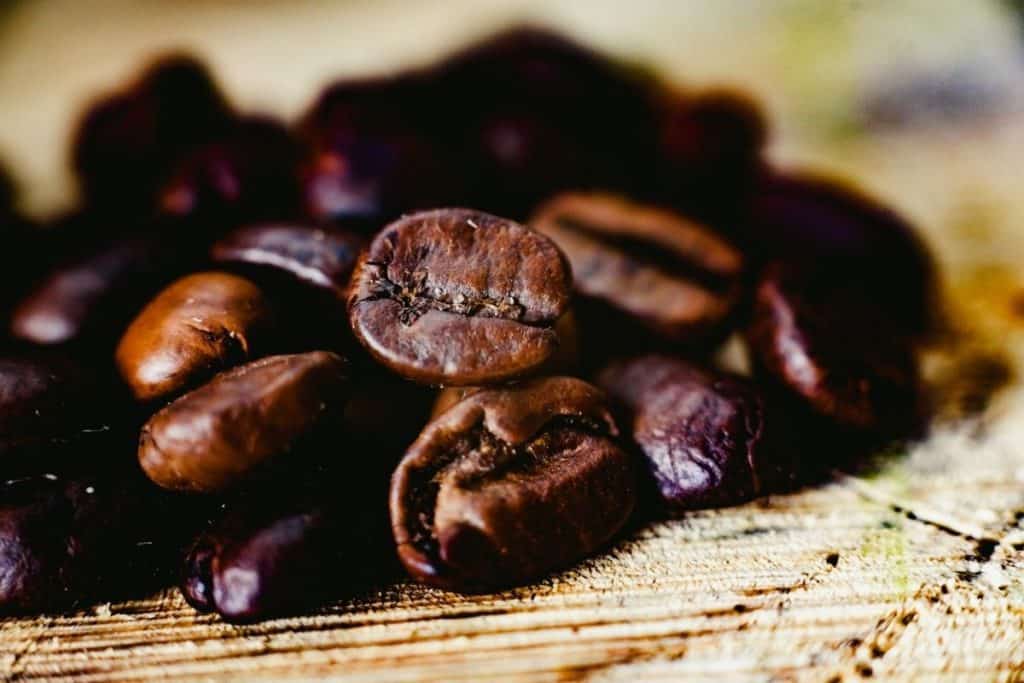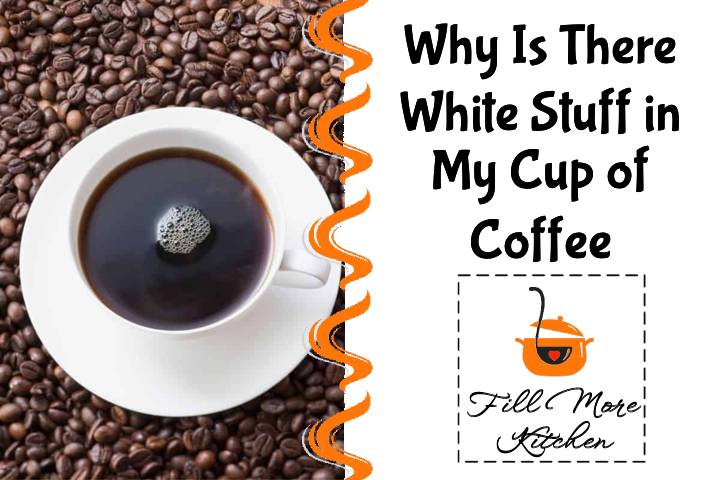After grinding my favourite coffee beans and brewing them, I was unpleasantly surprised to find little white specks floating on the surface of my hot coffee, which I spooned out.
As someone who drinks coffee regularly, I realized that it would be beneficial to know the identity of the white substance in my cup, prompting me to conduct research on the matter.
If you notice tiny white particles in your coffee, they could be coffee chaff, which is the dry outer layer of the coffee bean and safe to consume, or it might be spoiled milk or creamer if the specks only appear after adding them to your cup. In case of powdered creamer, the white specks may indicate that some particles did not dissolve properly.
What Is Coffee Chaff?
The dried husk of the coffee bean, also referred to as silverskin, is known as coffee chaff. The coffee bean may initially have a green color and no taste before the chaff is removed.
If the roasting process involves high temperatures, the chaff can come off effortlessly without any extra effort, unless it gets trapped in the crevices of the coffee bean. This may give an impression that it was not removed during roasting when you grind the coffee beans at home.
Why Is Coffee Chaff Considered a Nuisance?
Roasting your own coffee beans can be troublesome due to the presence of chaff, which is considered a waste product and has a very light weight, making it prone to spreading everywhere when dealing with large batches of roasted beans.
Roasters find it time-consuming to clean their equipment after roasting a large batch of coffee beans, which can be frustrating and has resulted in some inquiries.
- Is it possible to avoid coffee chaff?
Coffee chaff is an inevitable part of the coffee bean and cannot be avoided completely, unless the formation of it is stopped altogether, which would involve genetically modifying the coffee bean – a less desirable solution.
- Is it possible to decrease the amount that is generated?
If you are someone who roasts their own coffee beans, it is possible to decrease the quantity of chaff generated by roasting them in smaller portions or micro-lots.
- Is it Suitable for Other Purposes?
It is advisable to reuse coffee chaff as it can serve various purposes, such as being utilized as bedding for domestic pets or farm animals, mulch in gardens, or even compost, otherwise it will end up in a landfill.
How Do You Separate Coffee Beans and Their Chaff?
Whether you are experiencing chaff in your coffee due to home bean grinding or the roasting procedure will determine the answer to this question.
- Chaff in Ground Coffee Beans. When grinding your own whole coffee beans, you may come across chaff that was trapped in the crease of the bean, which appears as longer, thin, and light-colored flecks mixed with the fine grounds. If you want to remove it, you can either…
- If you notice white stuff in your coffee, you can remove it by picking it out and disposing of it properly. This method is effective if you only grind enough beans for a few cups of coffee.
- To prevent the appearance of white stuff in your coffee, try straining your coffee grounds before brewing them. You can use two colanders or a loose leaf tea holder to do this.
Ensure that you put a bowl or container underneath to catch the coffee grounds, regardless of the technique you employ.
- Chaff produced while roasting coffee beans. The method used to remove chaff from the beans may vary depending on the roasting process employed, but there are several common techniques.
- Separate the chaff from the beans using two colanders. Start by placing your recently roasted coffee beans into one colander, then transfer them to the other. Keep repeating this process until all the chaff is separated from the beans. Although most of the chaff will have already come off during roasting due to bean expansion, this method is useful for removing any remaining large pieces.
- Opt for either an air roaster or a drum roaster. Air roasters are highly effective in eliminating chaff since the airflow generated by the roaster will effortlessly carry it away. In case you cannot access an air roaster, a drum roaster is a satisfactory substitute as the heat and agitation during the process of roasting will cause the chaff to separate from the beans. Alternatively, you could roast your beans outdoors and let the natural breeze blow away the chaff.
- Experiment with DIY remedies. One option is to use a fan and two bowls to separate the chaff from the coffee beans. Simply transfer the beans between the bowls while holding them in front of the fan. Alternatively, place the beans between two mesh strainers, shake them, and then vacuum up any loose chaff. These are just a few suggestions, but there are many other methods you can try!
What If It Is Not Coffee Chaff in My Coffee?

If you are not personally grinding or roasting your coffee beans and instead using pre-ground commercial beans, the white specks in your coffee may not be chaff from the beans. In case you have doubts about it being chaff, there is a possibility that it could be something else.
- Powdered Creamer. When using powdered creamer, the white specks in your coffee may be due to incomplete mixing. To resolve this, stir it for a few minutes and check if it disappears. Occasionally, air gets trapped in the powder, forming a bubble or seal that traps particles. Breaking this seal should allow the dry powder to mix in properly. If not, remove it from the coffee.
- Liquid Cream or Milk. When using liquid creamer or milk in your coffee, the small white specks that you notice may be due to this. If the milk or creamer is close to its expiration date or has spoiled, it can separate and create those little white specks.
- High-Fat Cream. If you add high-fat cream to your coffee that is not very hot, the butterfat might not dissolve completely, which is a common occurrence in bulletproof coffee.
Why Is My Half and Half Curdling in My Coffee?
It is possible that you have observed the immediate curdling of half and half cream when mixed with hot coffee, while at other times it remains smooth and enjoyable. What causes this phenomenon? There are several explanations.
- Acid. When you add older cream to an already highly acidic cup of coffee due to additional acidic elements, the acid in the coffee will alter the pH balance of the cream or milk, causing it to curdle instantly.
- Temperature. When using older cream or milk in your coffee, the increased temperature of the coffee can cause it to curdle.
Although it may seem unappetizing, there is no cause for concern as this is a typical occurrence when coffee is mixed with cream or milk, known as beverage feathering or intentional curdling.
Note: Even if you use soy milk in your coffee, it can still curdle due to high acidity. To prevent this, pour the soy milk first or switch to low-acid coffee beans.
Is It Safe To Drink Curdled Milk and Cream?
Although curdled milk or cream is commonly considered spoiled, it may not always be the case. As long as it has not exceeded its expiration date or been left out on the counter all day, it is safe to consume curdled milk or cream in your coffee. Essentially, fresh milk or cream that curdles when mixed with coffee is perfectly fine.
Wrapping It Up
Observing white specks in your coffee does not always indicate that you should dispose of it.
If the white stuff in your coffee is coffee chaff, it is safe to consume and can be removed effortlessly. In case it is caused by powdered milk, you can either stir it until it dissolves or remove it manually. However, if the white substance is fresh curdled milk or cream, there should be no problem drinking it.
You can also check this video about “Why Is There White Stuff in My Cup of Coffee? (Can I Drink It?)”
Check out our top 10 reviews!
Related posts
https://fillmorekitchen.com/can-you-run-a-dishwasher-overnight/
https://fillmorekitchen.com/can-you-use-a-wok-on-an-electric-stove/
https://fillmorekitchen.com/kitchenaid-stand-mixer-vs-bread-machine-which-one-should-i-buy/
https://fillmorekitchen.com/should-a-gas-stove-always-be-hot/
https://fillmorekitchen.com/kitchen-appliance-durability-how-long-do-stand-mixers-last/



